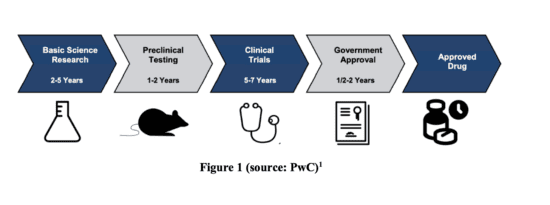THE CALIFORNIA BIOMEDICAL RESEARCH ASSOCIATION says that it currently takes an average of 12 years for a drug in the US to go from the research lab to the patient. Only one in every thousand drugs that begins pre-clinical testing ever makes it to human testing, and that has to happen five times before one gets approved. It costs companies an average of $359 million to take a new drug from the research lab to the patient.
It’s widely accepted that AI will be a game changer for life sciences. Discovering and creating new diagnostics and treatments will increasingly require dealing with huge amounts of data such as genomics, proteomics and transcriptomics. This data is large in volume and has many dimensions, and so only AI can analyze it to identify patterns and make predictions. It’s impossible for the human mind to understand how billions of genetic codes interact with the various mutations, as well as the relative contribution of each mutation.
AI allows us to look forward to an era of faster drug discovery, better clinical trials, better diagnostics and faster vaccine discovery (as with COVID-19). To realize this potential, we need to tackle many of the issues we’ve already discussed, and it all comes back to data. The data that we need to facilitate this change is in a chaotic format right now. The historic data collected while developing new molecules or looking for new targets isn’t in a usable format. The vast libraries of previous experiments by pharma companies contain data that wasn’t collected with AI applications in mind. Much of this data is on paper or collected in a narrative format, and so there’ll need to be a concerted effort to convert it into a more usable format.
AI could identify new targets or molecules that could cure or treat diseases that have been challenging to make progress with so far. Big pharma is struggling with profitability due to the high costs of research and development, as well as the low success rate for new drugs, how hard it is to enroll patients in clinical trials and pressure from various governments to reduce the price of pharmaceuticals. Because of that, pharmaceutical companies are constantly looking for ways to cut the cost of drug development and thus to become more profitable. For AI to help us to understand the causes of diseases, it will need access to huge amounts of data that are currently either inaccessible or don’t exist yet.
Creating and analyzing data that can identify promising compounds or targets takes a lot of time. Drug discovery can sift through a lot of data and find patterns. This can shorten the time it takes to discover the right targets and could also add precision to the process. Validating targets and optimizing leads alone can cost over $600 million and take more than four years.3 AI platforms are cutting down on discovery time by mining medical data—including omics data, scientific literature and clinical trials data—to identify new drug targets and predict optimal drug designs. They can lower pre-discovery costs by up to 90% and help us to better understand drug mechanisms and the structures of diseases.
In the next few posts, we will examine AI’s role in accelerating and improving drug discovery.






